The Bell UH-1B Huey: A Flying Symbol
The beloved Huey epitomizes the Vietnam War
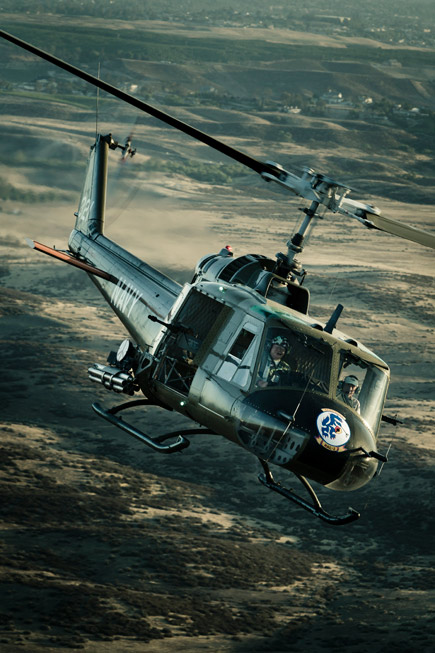 Seriously wounded and huddling in the dank underbrush, men struggled to stay alive and remain hidden from nearby and approaching Viet Cong guerillas. As their plight became increasingly desperate, the isolated American soldiers began to hear in the distance the distinctive slapping of rotor blades. There was no mistaking the whop-whop-whopping of a Huey. It was the sound of rescue, the sound of freedom, the sound of going home—sentiments almost universally expressed by those who were there.
Seriously wounded and huddling in the dank underbrush, men struggled to stay alive and remain hidden from nearby and approaching Viet Cong guerillas. As their plight became increasingly desperate, the isolated American soldiers began to hear in the distance the distinctive slapping of rotor blades. There was no mistaking the whop-whop-whopping of a Huey. It was the sound of rescue, the sound of freedom, the sound of going home—sentiments almost universally expressed by those who were there.
“Charlie” heard it, too, and knew that to be discovered by the crew of a Huey gunship would put them in a world of hurt. Such an enemy ground unit often retreated, wisely abandoning its prey.
More than any other aircraft, the beloved Huey symbolizes the Vietnam War and the American heroes who served and sacrificed there. The iconic helicopter was developed specifically for the United States military and first flew on October 20, 1956. The Army’s first turbine-powered helicopter, it was originally designated as the HU–1 Iroquois, the pronunciation of which is the origin of the Huey epithet. The aircraft was redesignated as the UH–1 in 1962, but the familiar nickname stuck. “Huey” became so popular and immortal that Bell began casting the name on the anti-torque pedals. Its official name, Iroquois, is rarely used except when referring to a nation of Native Americans.
The Huey was responsible for a new breed of U.S. military pilot, the warrant officer, who could go directly into flight training from high school without having to undergo the rigors of becoming a commissioned officer.
Unsightly wreck
The aircraft on these pages, N832M, was built in 1963 and served in Vietnam with the 101st Airborne and 1st Cavalry divisions between 1964 and 1966. Following military discharge, it returned stateside, eventually flew for the Lee County (Florida) Mosquito Abatement Program, and became an unsightly wreck. It was purchased by the Wings and Rotors Air Museum in 2001 for only $10,000. It then had a painstaking and thorough two-year restoration.
During the restoration, graffiti was discovered on the inside surfaces of the tail boom. This was left undisturbed as a tribute to Army maintenance personnel who had worked on the aircraft in Vietnam. Although 1,010 UH–1Bs have been built, this likely is the only gunship that is still airworthy. It is used primarily for airshows, static display, parades, veterans’ events, and fly-bys.
As a gunship, the Huey normally had a crew of four, two pilots and two gunners. Each pilot has his own entry door, and the cabin has two large doors that slide aft, making the aircraft suitable for a wide variety of utility roles. The gunship was used primarily to clear landing zones for troop-carrying helicopters and to provide close-air support for ground units. It also was used for troop transport, medevac, emergency resupply, and armed attack. The Huey was the Jeep of the Vietnam War.
The gunship carried effective and concentrated firepower. The deactivated armament aboard this Huey is typical and includes a traversable M134 Minigun with six rotating barrels that could fire 6,000 rounds per minute; a pair of rocket launchers that each fired seven 2.75-inch, folding-fin rockets; a .50-caliber machine gun; and a 7.62-mm M60 machine gun. The only thing missing is a grenade launcher in the nose. During combat the cabin floor was typically stacked with ammo boxes and grenades that could be tossed overboard to accommodate rescued personnel.
The two probe-like devices on the nose are FM antennas. They were used to locate ground troops broadcasting homing signals on discrete frequencies that were changed daily.
Noticeable during the walkaround inspection are numerous small riveted patches covering bullet holes from when this aircraft encountered small-arms fire during the war. The red-and-white peace symbol on the side of a Huey was sarcastic reference to the “peaceniks” at home and was intended to mean “Peace through Firepower.”
Easiest helicopter to fly
I was instructed in the Huey by Pat Rodgers, the museum’s executive director and chief pilot. He also is a distant cousin of Cal Rodgers, who in 1911 was first to fly across the United States. Most of his 3,000 hours are in helicopters, including 1,200 in Hueys and 1,200 in a Bell OH–58 Kiowa (military version of the Model 206 Jet Ranger).
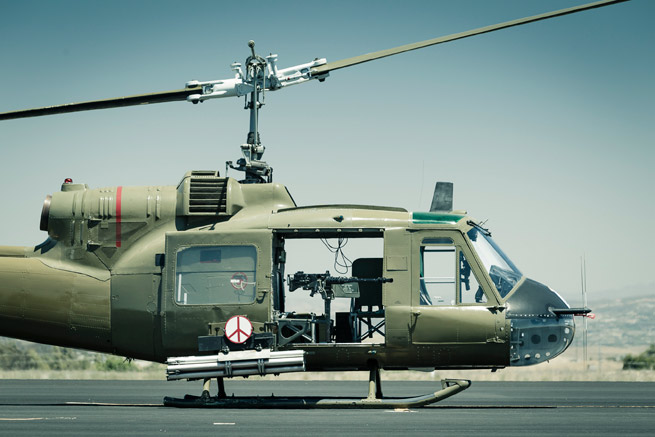
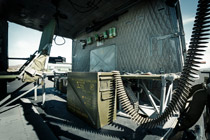
Rodgers assured me that I would have little trouble flying the Huey. “It’s the easiest helicopter I have ever flown,” he said. “It was designed and built to be flown with confidence under a wide variety of conditions, many of them adverse.”
Substantial airframe shaking occurs as the two-blade rotor accelerates while starting the Lycoming T53-L-11 turboshaft engine—so much that it is almost impossible to read small instruments or set the altimeter at the same time. The shaking dies down, though, as the engine and rotor stabilize at idle. (A Huey cockpit would be a perfect place to mix a martini for James Bond.)
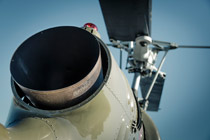
The collective and hydraulically assisted cyclic control and anti-torque pedals are conventional. The aircraft also has a synchronized elevator near the end of the tail boom. It is mechanically linked to the fore-and-aft movement of the cyclic to increase pitch control and widen the center-of-gravity envelope.
After starting the 1,100-shaft-horsepower engine, you twist the motorcycle-grip-like throttle on the collective, simultaneously accelerating the engine to 6,600 rpm and the rotor to 324 rpm. After that, a governor automatically maintains these speeds and the throttle is no longer needed (except during shutdown).
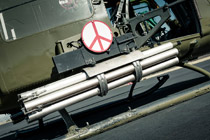
Raise the collective slowly and feed in left-pedal pressure until the Huey gets light on the skids. Raise the collective a bit more, pull into a hover, lower the nose, add more collective, and you’re on you’re on your way, climbing more than 1,200 fpm at the best climb speed of 60 knots.
With weaponry hanging in the breeze and cabin doors open, the Huey cruises at 85 knots, 90 to 95 knots when cleaned up and with the doors closed. It is difficult to inadvertently exceed redline airspeed because of the unmistakable buffeting that occurs when approaching VNE (120 knots).

I had been under the impression that the familiar slapping sound of the two wide-chord rotors could be heard only when outside the aircraft, but you can hear it from inside as well. It is particularly noticeable during turns (when disk loading is increased) and when airspeed is less than 70 knots. Low fly-bys are made at low speed to maximize blade slapping and create a genuinely crowd-pleasing effect. This distinctive slapping is not unique, however; a similar sound is made by the Bell AH–1 Cobra and the Bell 222. Unfortunately, the rotor blades have only a 1,000-hour service life. Replacements from Bell cost $100,000 per blade.
The Huey autorotates beautifully and makes you appreciate the high-inertia rotor blades, which make it easy to maintain safe rotor speed during descent. A normal approach is made from 300 feet and 60 knots while maintaining an eight- to 10-degree descent profile. Initial touchdown occurs on the rear of the tubular skids.
The UH–1B is an honest, stable, and relatively easy helicopter to fly. My greatest challenge in flying any helicopter is hovering and making pedal turns (pivoting turns while hovering) at three feet in a crosswind. I did not do all that well in the Huey but much better than I had anticipated, considering that my 300 hours of helicopter experience are spread over 50 years. This was more of a tribute to the Huey than it was to me.
I cannot say that I enjoyed flying the Huey. I can say that I loved it—every minute of it.
Flying Thunder
There are three basic models. The UH–1B is one of the “short bodies.” Stretching the fuselage 41 inches to increase troop-carrying capacity resulted in the UH–1D. Replacing the single turbine with a pair of Pratt & Whitney engines produced the UH–1N Twin Huey.

More than 16,000 Hueys had been built when production ended in 1986. Seven thousand of them served tours of duty in Southeast Asia. Civilian versions of the Huey are the Bell 204 (short-body), the Bell 205 (stretched), and the twin-engine Bell 212.
During May 2008, Rodgers and his Huey were joined by two other helicopters, the museum’s Bell OH–58 Kiowa and a second Huey belonging to Overseas Aircraft in Lakeside, Arizona. They formed a flight of three, headed east from Southern California, and referred to themselves as “Flying Thunder.” Their goal was to arrive and pay homage at the Vietnam Veterans Memorial (the “Wall”) in Washington, D.C., on Memorial Day along with Rolling Thunder, many of whom arrive as a huge gathering of motorcyclists. Sadly, the trio of ex-military helicopters was denied permission to enter restricted airspace and fly the last mile to honor the 58,286 veterans whose names are inscribed on the black granite wall. Instead, the helicopters had to land short at Leesburg, Virginia.
“The price of our freedom is engraved on that wall,” Rodgers laments, “and they wouldn’t even let one Huey make one blade-slapping fly-by.”
A cruel aspect of the Vietnam War was the bitter homecoming experienced by so many returning veterans. They often were confronted by anti-war protestors, spit upon, called baby killers, cursed, and assaulted. They were scapegoats for an unpopular war and often accused of being drug addicts, psychos, and war mongers. These U.S. veterans were one of the most unjustly maligned groups in American history, causing many to discard their uniforms and medals, keep to themselves, and rarely discuss the war.
SPEC SHEET
Bell UH–1B Iroquois (the Huey)
Powerplant | Lycoming T53-L-11 turboshaft, 1,100 shp
Recommended TBO | 1,200 hr
Length (overall) | 52 ft 11 in
Height (to top tip of tail rotor) | 14 ft 7 in
Main rotor diameter | 44 ft 3 in
Main rotor disc area | 138.9 sq ft
Disc loading | 61.2 lb/sq ft
Power loading | 7.7 lb/shp
Tail rotor diameter | 8 ft 6 in
Skid track | 7 ft 10 in
Seats (as a gunship) | 4
Seats (as tested) | 9
Cockpit width | 6 ft 6 in
Cabin width | 7 ft 10 in
Cabin length | 8 ft 6 in
Cabin height | 4 ft 10 in
Empty weight (as tested) | 4,541 lb
Max gross weight | 8,500 lb
Useful load (as tested) | 3,959 lb
Payload w/full fuel (as tested) | 2,853 lb
Fuel capacity, std | 165 gal (all usable) 1,106 lb (all usable)
Oil capacity | 13 qt
Performance
Normal cruise speed | 90 kt
Fuel consumption (75% power) | 76.8 gph (514 pph)
Max range | 235 nm
Max endurance | 2 hr 9 min
Rate of climb, sea level | 1,210 fpm
Hover ceiling (in ground effect) | 12,500 ft
Hover ceiling (out of ground effect) | 8,200 ft
Service ceiling | 19,390 ft
Autorotation (glide) ratio | 4.25:1
Limiting and Recommended Airspeeds
VY (best rate of climb) | 60 KIAS
VNE (never exceed, light weight) | 120 KIAS
Max rearward, sideward speed | 30 KIAS
Autorotation (normal) | 55-60 KIAS
Autorotation (min sink) | 45 KIAS
Autorotation (max range) | 73 KIAS
All specifications are based on manufacturer’s calculations. All performance figures are based on standard day, standard atmosphere, sea level, gross weight conditions unless otherwise noted.
Extra: Early UH–1 models featured a single Lycoming T53 turboshaft engine in versions with power ratings from 700 shp to 1,400 shp.
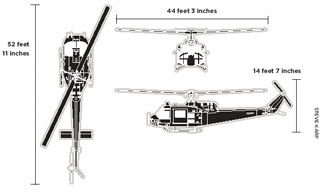

Related Articles
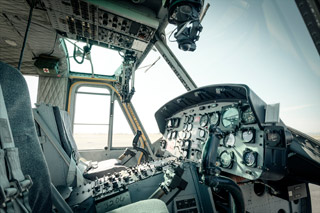
Rodgers uses the museum’s Huey to provide memorial flights to Vietnam vets. “The flights help some veterans to confront their pasts and remind them that their sacrifices were indeed appreciated,” Rodgers says.
Flying Thunder’s attempted roundtrip to the wall took 22 days, covered 6,000 miles—a very long trip in a Huey—and included landings in 43 cities, during which many such memorial flights were conducted.
During a stop in Alabama, a member of the Purple Heart Association told Rodgers of his last flight in a Huey. Badly injured, all he could remember was staring at the ceiling. When offered a ride, he didn’t want to go, but finally relented. He returned with tears of joy. “That flight made a big difference in my life,” he later told Rodgers. “It helped me to get rid of some really bad demons.”
“When we landed in Dalhart [Texas],” Rodgers said, “they shut down the town and closed the schools. It seems as though everyone came out to see and touch the Hueys.”
At one of the stops, a woman pointed to the pilot’s seat and asked, “May I sit there?” Rodgers assisted her into the cockpit. She tearfully explained that she had never met her father, but “this is where he was when he was killed.”

Rodgers has landed at veterans’ hospitals and tells of how the mere sight of a Huey has enabled some vets to begin speaking about their experiences for the first time. A veteran infantryman who had been medevacked in a Huey had recurring nightmares about his Vietnam experience but begrudgingly agreed to fly with Rodgers. A week later he reported with great relief that his nightmares had abated. “Our Huey,” says Rodgers “is a therapeutic piece of hardware, a flying symbol of remembrance. We regard it as a token of gratitude to those who sacrificed so much for our freedom.”
The Wings and Rotors Air Museum is at the French Valley Airport in Murietta, California. It was founded in 2000 by Rodgers (and an anonymous benefactor) and has several Vietnam-era aircraft, including the Kiowa and a restored McDonnell Douglas F4H-1 Phantom II. Many of the volunteers are vets who have had experience with Hueys and love being around them. Further information is online.
Photography by Mike Fizer
Web: www.barryschiff.com


